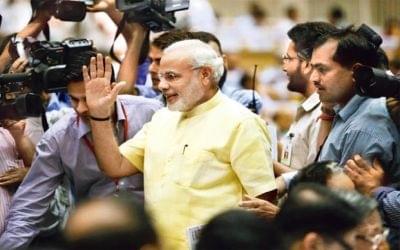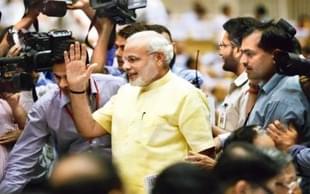Commentary
Is Modi the Ideal Choice?
Kalavai Venkat
Jan 07, 2014, 02:40 AM | Updated Apr 29, 2016, 01:05 PM IST
Save & read from anywhere!
Bookmark stories for easy access on any device or the Swarajya app.


Narendra Modi has given a corruption-free, development-focused, and efficient rule in Gujarat. Even such an extreme left ideologue as Justice V. R. Krishna Iyer recognizes this and confirms that Modi “is not a corrupt leader.” Iyer also aptly points out that “Gujarat has set an example to the whole country with the successful implementation of solar projects” and that “it is very important for the nation to have Modi as its Prime Minister. He is very capable.” Gujarat under Modi is the best ruled Indian state and the infrastructure and development initiatives speak for themselves. Modi is the only prime ministerial aspirant who doesn’t indulge in communal vote bank politics.
I would like to see Modi become the prime minister in 2014 (this is not an endorsement of the BJP though) for two reasons. First, if he replicates the corruption-free and development-oriented administration that he gave Gujarat all over India, all Indians would benefit. Second, there is no alternative. The corrupt, criminal, and inefficient UPA should be annihilated. Coalition governments invariably lead to rampant corruption. I would eventually like to see Arvind Kejriwal emerge as a credible rival to Modi on the national stage. However, at the moment, Aam Aadmi Party (AAP) doesn’t have a footprint outside Delhi. Besides, while I admire Kejriwal’s honesty, intelligence, and courage, as I have argued, AAP’s stance on gram sabha and nuclear energy is highly detrimental to India’s future. These factors rule out any alternative to Modi in 2014.
However, is Modi the ideal choice for prime minister?
America’s Christian evangelical demagogues and their Indian-American leftist minions teamed up with a few unscrupulous U.S. congressmen to launch a smear campaign against Modi. As a result, United States humiliated Modi by revoking his visa on the false pretext that he masterminded the Gujarat riots of 2002. America has always eagerly collaborated with dictators, e.g., Saudi royal family, Chinese Communists, and Pakistani usurpers. It benefits the greedy and parasitic American corporations. If Modi was seen as a strong leader and an obstacle to the evangelizing of India, one could expect the U.S. administration under the sway of the Christian right wing to humiliate and undermine him.
In 2013, Modi was again humiliated when the Wharton Business School canceled the keynote address he had been invited to deliver. The U.S. establishment continues to insult Modi by announcing that even if he were to become the prime minister, he still has to apply for U.S. visa and eagerly await review by a low-level immigration official.
The American conduct in these infamous episodes is understandable because it follows a pattern of unscrupulous behavior. A foreign ruler who is an American lackey is endorsed whereas a strong leader who paves the way his country’s independence from the War Inc. is denounced. Abdul Kalam, who led India’s missile programs and thereby undermined the greedy pursuits of the U.S. War Inc., too was frisked and humiliated at U.S. airports with scant regard for international conventions.

Modi’s response to the humiliation heaped on him is hard to understand though. A principled stance that in the event he becomes the prime minister of India he would ban the entry of American presidents, senators, and congressmen guilty of endorsing predatory wars and causing genocides would have been in order. He could’ve announced that there would be reciprocal frisking of a former American president for the humiliation heaped on Kalam. Instead, Modi invited the American diplomats to attend his election rally in Mumbai.
The invite was only rescinded because of the humiliating treatment of the Indian diplomat Devyani Khobragade in the U.S. which resulted in public outrage in India. Does Modi believe that appeasement is the only way to deal with unfair American bullying? Strong leaders take courageous stances and do not submit to bullying. One must remember that despite the corruption she unleashed, Indira Gandhi did not blink in the face of Western bullying during the 1971 Indo-Pak war and the 1973 nuclear weapons testing even though India was a comparatively weaker power then.
Edward Snowden, in a courageous exposé, revealed that America’s security agencies have been spying on citizens as well as friendly foreign states. He revealed that Indian agencies were spied on too. This kind of illegal surveillance creates an environment of fear, undermines free speech, violates individual privacy, jeopardizes friendly bilateral relationships, and eventually weakens American society. None but the War Inc. stands to benefit from such surveillance. Predictably, the vested interests in the American establishment launched a witch-hunt to silence Snowden, who sought asylum in India. The spineless UPA government rejected the asylum petition without a public discussion. It was surprising that Modi didn’t express opinion on the Snowden affair. Wouldn’t a strong leader take a stance on granting asylum to a conscientious whistleblower who warned of the spying on Indian agencies?
India is a land of huge disparities. Between 22 and 67 percent of Indians live under conditions of abject poverty depending on how one defines poverty line. Their plight cannot be alleviated by turning India into the call center and IT outsourcing hub of the West. Handling low-end jobs for the West might be alluring to begin with. However, in the long run, outsourcing leads to erosion of skills and kills innovation. As a consequence, society fails to generate enough wealth to uplift all sections of population. India must invest in infrastructure and technologies of the future because those would be the catalysts to innovations, economic growth, and wealth generation.
The Duke University neuroscientist Murali Doraiswamy shows that interdisciplinary quests result in innovation. His team collaborated with Lumos Labs scientists to leverage Luminosity’s giant dataset to study the effects of sleep, alcohol, and age on working memory, spatial memory, and quick arithmetic (see Science News, December 14, 2013, pp. 18-19). This underscores the need to comprehensively invest across the entire spectrum of the technology infrastructure as a prerequisite to making innovative advances in diverse fields.
China understands this and has been investing in such infrastructure-related initiatives. An example of such initiative is the Binhai Cloud Computing Park, situated within the Tianjin Economic-Technological Development Area (TEDA). Its cloud-computing platform boasts of a Tianhe supercomputer and cutting edge software capability to support financial risk analysis and pharmaceutical research (see The Economist, December 21st 2013 – January 3rd 2014, p. 23). China also understands that system interoperability actually renders China vulnerable and favors American corporates and the War Inc. As a result, it has invested heavily in non-interoperable system technologies, hardware, and software. Supercomputing is one such field which China has pursued seriously. As a result, China’s Tianhe-2 has emerged as the fastest supercomputer in the world. At 33.9 petaflops it is twice as fast as America’s Titan.
Chinese are developing their own Internet protocols, operating systems, search engines, switches, routers, mobile technology gear, and signal processors thereby creating a secure system that gives them the power of reciprocity and minimizes vulnerability to imperialistic predations. In contrast, India doesn’t have any hardware or software capability. WikiLeaks and Snowden files reveal that India’s dependence on interoperable technology makes it vulnerable to Western predations.
Let us look at an interesting factoid. In 2010, the fastest supercomputer only clocked 3 petaflops. In a mere three years, supercomputer speeds have increased by an order of magnitude. Therefore, if India fails to formulate a technology vision and invest in infrastructure now, she would be left far behind global competition in the years to come. Such a state would diminish her ability to fight poverty and to emerge as a wealthy nation.
An ideal leader must be capable of understanding this reality and formulating a futuristic economic-technological vision. Modi hasn’t done so. Economic-technological progress of the future would be made on the foundations of a high-end educational system and research facilities. Modi hasn’t built any such institution in Gujarat. Modi’s model of economic development has been dependent on efficient commerce. While commerce is a necessity, it is merely a subset of an economic-technological system which would thrive on innovations in the future to generate wealth. Commerce is not the engine of economic growth.
One may conclude that Modi is the inevitable choice as the prime minister in 2014 only because of the lack of an alternative. No doubt that if he were to replicate his Gujarat model of corruption-free, efficient administration all over India, all Indians would benefit. However, Modi is not the ideal choice. An ideal choice would be a visionary leader capable of understanding the emerging trends in the economic-technological horizon and formulating a comprehensive plan that would lead to innovations and wealth generation.
Kalavai Venkat is a Silicon Valley-based writer, an atheist, a practicing orthodox Hindu, and author of the forthcoming book What Every Hindu Should Know About Christianity.





